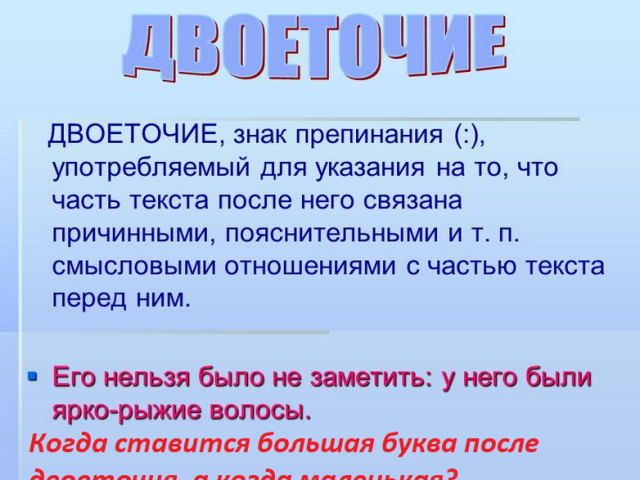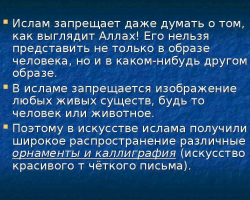Often a person does not know, after a column, write with a capital letter or small. You need to know the rule, and examples will help to fix the material.
Content
- When a colon is put in the sentence: rule
- When a large letter is written after a colon: rule, examples
- When a small letter is written after a colon: rule, examples
- List design: How is it right?
- Video: How to write correctly: Choose between a colon and dash!
- Video: colon - where, when and why put it?
- Video: Russian language grade 9. A colon in a non -union complex sentence
The Russian language is complex, because for the correct spelling, you need to know the rules by heart. Naturally, they must be taught at school and only then, in adulthood, when the main basic knowledge has already been deposited in the head, it will be possible to write competently on an intuitive level.
Read on our website another article on the topic: "The word" homeland "is written with a capital letter or not?". You will find out why, and you will also find rules and examples.
From this article you will learn when a colon is put in the sentence. Such knowledge will be needed if you are studying at school or just forgot the material passed. Read further.
When a colon is put in the sentence: rule
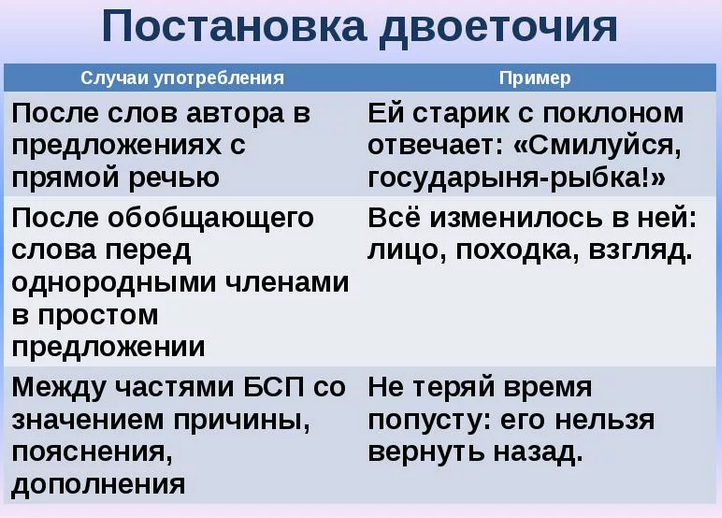
Colon - This is such a symbol without which any phrase automatically loses its original meaning. Therefore, each person should know the rules for staging a colon and distinguish them. Colon - This is a type of punctuation in which two points are located one above the other. It is used after generalization and in the list of homogeneous members in the sentence, as well as after the writer's dialogue in direct speech. Two points Parts of the incoherent complex sentence are separated, which are somehow connected with each other.
In punctuation, according to the rule of our native language, there are many examples of using a colon in phrases and other statements:
- Indirect speech
- Citation
- Complex phrases of free shape
- Minor members of proposals
Therefore, it is necessary to consider whether the capital or small letter should be behind the colon. You need to know that the colon does not share phrases. This symbol is placed inside the sentence. It is used to divide phrases according to the semantic part. But questions arise about writing words after this punctuation mark. Often, word forms are written, starting from lowercase letters.
The dividing symbol of the “colon” \u200b\u200bbegins to be used from the end of the 16th century. It is mentioned in the grammar of Lavrenty Zizania, Metlei Smozitsky (1619).
When a large letter is written after a colon: rule, examples
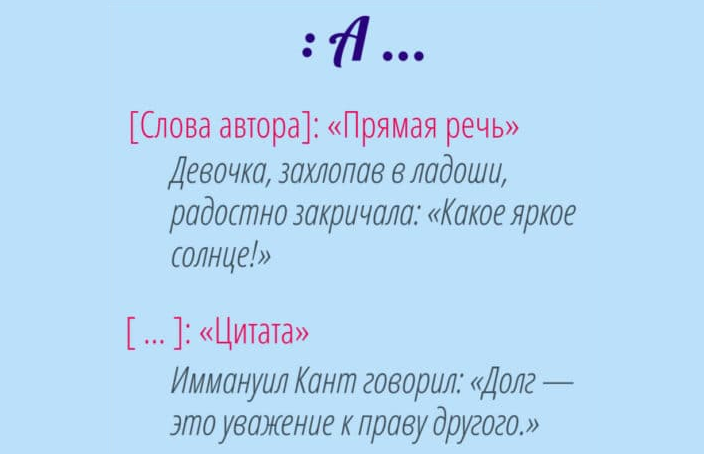
After the colon, a large letter is written in such cases - Rules:
- Direct speech - This is a conversational phrase of another person (not a writer of the story), taken directly from the story and conveyed literally. When it comes after the phrases of the writer, you need to write with a capital letter.
Example:
- The prosecutor stood up and said: "Based on the testimony, the meeting can be considered closed."
- Alexander Nevsky said: "Who will come to us with a sword - from the sword and die."
- Citation - accurate reproduction of a fragment of a work or phrase of another person. If the text has quoting the phrase, it must be enclosed in quotation marks.
Example:
- Pushkin wrote to Chaadaev: “My friend, the Fatherland will devote beautiful impulses!”
- A. de Saint-Exupery in the famous fairy tale wrote: "Children should be condescending to adults."
Remember: When someone's phrase is not quoted, but is transmitted as indirect speech, then it is written with a small letter and a colon is not necessary.
When a small letter is written after a colon: rule, examples

Consider the spelling options of a small letter after a colon - Rules:
- When there is a generalization in the phrase, and after it there are homogeneous members.
Example:
- Walking to the site with his son, we take a lot of things: scooter, cars, ball.
Remember: If there are own names, then they must always be written with a capital letter!
Example:
- In St. Petersburg, children saw many beautiful attractions: Hermitage, Petrovsky Fortress and Isaac's Cathedral.
- She loved sweets very much: sweets, marshmallows and marmalade.
- There are many minerals in the bowels of the Urals: iron, copper, coal and precious stones.
- Old fruit trees grew near the house: apple trees, pears and plums.
- Unionless complex sentence.
Example:
- They need to hold an urgent meeting: this is an urgent issue.
- Vanya did not watch the series: electricity was turned off in the house.
- No one could assume such an end to the working day: because of the strongest rain, it would be difficult for people to get home.
As you can see, everything is simple - you only need to know the rules and fix them with examples. There is nothing difficult to memorize such a grammar of the Russian language.
List design: How is it right?
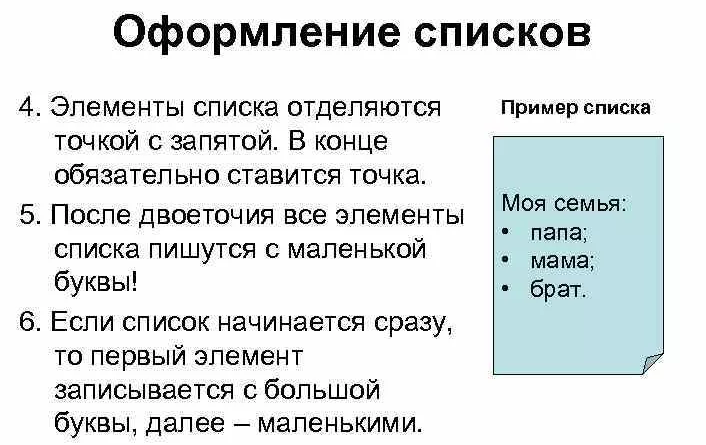
The list is created in accordance with certain norms. There are conditions on which it depends on which letter will be used in the enumeration. So, how to make lists correctly? With which letter each element of the list begins, depends on some nuances. Read more:
Designation of the elements of the listing:
- G., D., E. - large letters with a point
- IV., V., VI.; 4., 5., 6. - Roman or Arab digital symbols with a point
- d), e), e) - a small letter or a digital element with a bracket
- Dash
- Graphic symbol (rhombus, square, etc.)
How many levels are in the list:
- One
- A lot of
The degree of distribution of each element can be from:
- One phrase, phrases
- Separate sentence, full paragraph
What symbol is placed at the end of the paragraph:
- Comma
- Semicolon
- Dot
We will study the basic rules that are always used in the lists of something:
- Когда абзацы выделены большой буквой с точкой, а также римскими или арабскими символами с точкой, then they should be written out with a capital letter. At the end, put a point.
For example, pit will be such accessories for the school:
A. Notebooks.
B. Literature for training.
V. Chancellery.
- If the list elements begin with the number or letters with a bracket, dash or graphic symbol, then there is a small letter. At the end of the paragraph, put a comma or point with a comma.
For example, pit will be such accessories for the school:
a) notebooks;
b) books for learning;
c) office.
- The first level of the list usually begins with a capital letter or number, and the second and the following - with a small. The first level is indicated by large letters or numbers with dots, and the lower levels are indicated by small letters or numbers with brackets, hyphen or graphic hieroglyphs.
An example is a list of accessories for the school:
1. Notebooks:
d) checkered and linear,
e) thick and thin.
2. Educational literature:
d) in English,
e) on geography,
e) in chemistry.
3. Chancellery:
d) Lastik,
e) pencil,
e) pens.
- Paragraphs that are considered complete phrases or common are written with a capital letter. At the end, put a point.
An example - for the preparation of a soup, you need:
- Buy meat fillets and vegetables, clean and crush everything in advance.
- Boil water.
- In turn, add the necessary ingredients.
- If the elements of the list are one word or word-combination, then they are usually written with a small letter, and at the end of each it is worth putting a comma or a point with a comma.
For example - a list of products:
- chicken,
- buckwheat,
- beet,
- garlic,
- spices.
As mentioned earlier, when a point is used in the conclusion of the paragraph, then the next paragraph will be written with a capital letter. When a comma or a point with a comma is set, then the next paragraph must be discharged from the lowercase letter.
Video: How to write correctly: Choose between a colon and dash!
Video: colon - where, when and why put it?
Video: Russian language grade 9. A colon in a non -union complex sentence
Read on the topic:

